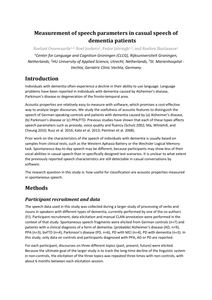From the article: "Individuals with dementia often experience a decline in their ability to use language. Language problems have been reported in individuals with dementia caused by Alzheimer’s disease, Parkinson’s disease or degeneration of the fronto-temporal area. Acoustic properties are relatively easy to measure with software, which promises a cost-effective way to analyze larger discourses. We study the usefulness of acoustic features to distinguish the speech of German-speaking controls and patients with dementia caused by (a) Alzheimer’s disease, (b) Parkinson’s disease or (c) PPA/FTD. Previous studies have shown that each of these types affects speech parameters such as prosody, voice quality and fluency (Schulz 2002; Ma, Whitehill, and Cheung 2010; Rusz et al. 2016; Kato et al. 2013; Peintner et al. 2008). Prior work on the characteristics of the speech of individuals with dementia is usually based on samples from clinical tests, such as the Western Aphasia Battery or the Wechsler Logical Memory task. Spontaneous day-to-day speech may be different, because participants may show less of their vocal abilities in casual speech than in specifically designed test scenarios. It is unclear to what extent the previously reported speech characteristics are still detectable in casual conversations by software. The research question in this study is: how useful for classification are acoustic properties measured in spontaneous speech."
MULTIFILE

DOCUMENT

Background: Goal setting is an essential step in the clinical reasoning process of speech and language therapists (SLTs) who provide care for children, adolescents and adults with communication disorders. In the light of person-centred care, shared or collaborative goal setting between the SLT and client is advised in (inter)national guidelines. SLTs face challenges in implementing (shared) goal setting as theoretical frameworks and practical interventions are scarce and less applicable to use with a wide range of communication vulnerable populations. Aims: A first step in developing theory and practical interventions is to explore first-hand experiences of SLTs and clients about day-to-day goal-setting practice. This study was guided by the following research question:What are the perspectives and needs of SLTs and persons with communication disorders regarding (shared) goal setting in routine SLT services? Methods & Procedures: The qualitative study was carried out in the setting of routine speech–language therapy services in community practices, primary education and neurological rehabilitation in the Netherlands. Data collection followed the principles of video-reflexive ethnography, using video footage of goal-setting conversations to facilitate semi-structured, reflexive interviews.Data analysis was based on reflexive thematic analysis. A total of 12 interviews were conducted with client–SLT dyads, covering perspectives from children, parents and adults with a range of communication difficulties and their SLTs. Outcomes & Results: Data analysis resulted in four themes, of which two contain subthemes. Each theme represents a central organizing concept found in SLT and client interviews. The themes were identified as: (1) goal setting is a complex process; (2) goal talk needs to be communication accessible; (3) communicative participation goals are hard to grasp; and (4) the importance of relationships. Topics such as power imbalance, communication vulnerability, effective communication strategies, and motivation and trust are explored under these themes. Conclusions & Implications: SLTs are encouraged to view shared goal setting as a process that needs to be explicitly planned and communicated with clients regardless of their age or communication vulnerability. SLTs have expert knowledge and skills when it comes to supporting communication and applying these skills during goal talks might strengthen shared goal setting and foster a therapeutic relationship. There is a need to concretely conceptualize and embed shared goal setting in policy and clinical guidelines. The themes reported have tentative clinical implications for developing such policy, and shared goal-setting interventions for SLT practice, under the condition that SLTs and people with communication disorders are continuously involved.
MULTIFILE
